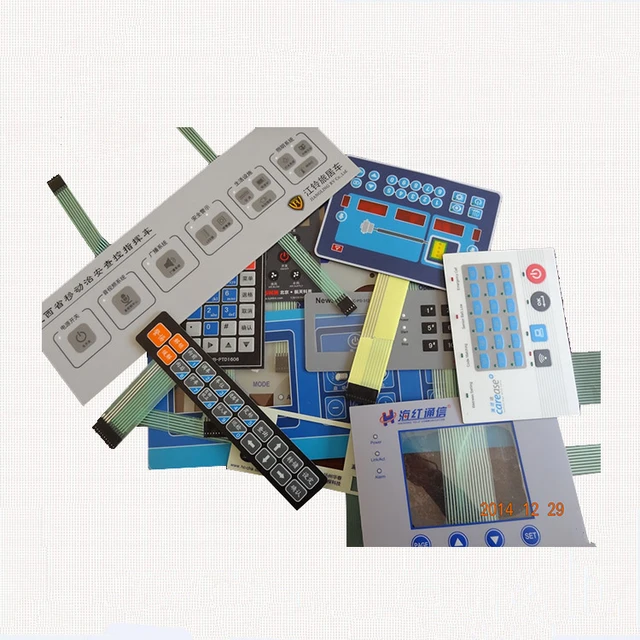The Role of Membrane Switches in Enhancing Device Functionality
The Role of Membrane Switches in Enhancing Device Functionality
Blog Article
Understanding Membrane Switches: The Key to Trustworthy and long lasting Controls

What Are Membrane Buttons?
Membrane buttons are a sophisticated service in the world of user interface technology, integrating capability and layout seamlessly. These devices function as a user interface between individuals and digital systems, incorporating a number of parts right into a small style. Normally constructed from versatile, slim layers of products, membrane buttons are made to reply to touch, allowing users to communicate with machinery and digital tools properly.
The main aspects of a membrane layer button include a published circuit layer, visuals overlay, and a spacer layer that protects against unexpected activation. The graphic overlay can be customized to reflect brand name identification or user choices, improving looks while making sure functionality. Membrane layer switches are frequently used in numerous applications, consisting of medical gadgets, customer electronics, and commercial devices, owing to their toughness and resistance to environmental aspects such as dampness and dust.
Among the vital advantages of membrane buttons is their capability to stand up to damage, making them optimal for high-traffic environments. Additionally, they are light-weight and call for minimal space, allowing for innovative designs in item advancement. On the whole, membrane changes represent a effective and practical selection for modern digital user interfaces, marrying modern technology with user-centric style principles.
How Membrane Changes Work
The operation of membrane layer switches joints on an easy yet efficient system that converts customer input right into electronic signals. When an individual presses the button, the leading layer deforms, allowing a conductive aspect in the circuit layer to make call with a matching conductive pad on the bottom of the visuals overlay.
The layout of membrane switches can vary, but they usually include domes or responsive aspects to give feedback to the individual, boosting the overall experience - membrane switch. The materials made use of in membrane layer buttons, such as polyester or polycarbonate, add to their resilience and resistance to environmental variables, consisting of wetness and dust. Additionally, the published circuits are generally enveloped, which protects them from deterioration gradually.
Advantages of Membrane Layer Switches

Additionally, membrane switches are understood for their resilience. Built from robust products, they are resistant to dust, moisture, and physical wear, which dramatically expands their life expectancy contrasted to traditional mechanical switches. This resilience makes them particularly ideal for high-traffic atmospheres and applications requiring long life.
Another substantial benefit is the convenience of cleaning and maintenance. The smooth surface area of membrane layer changes minimizes dust build-up and is usually impervious to spills, making them perfect for setups that require constant sanitization.
In addition, membrane buttons use a structured profile, resulting in a thinner style that can be incorporated right into various tools without including mass. This feature not only improves the aesthetic appeal but also adds to a much more ergonomic item style.
Applications of Membrane Layer Switches
Functional and user-friendly, membrane layer switches find applications throughout a variety of sectors, consisting of medical tools, consumer electronic devices, and commercial tools. In the clinical area, these switches are indispensable to devices such as analysis devices, individual surveillance systems, and mixture pumps, where reliability and ease of cleansing are important. Their capacity to preserve and hold up against extreme atmospheres performance makes them suitable for such applications.

In customer electronics, membrane layer switches are made use of in products like microwaves, cleaning makers, and remotes - membrane switch. Their streamlined design allows for user-friendly individual interfaces, improving the overall individual experience while giving durability and resistance to tear and put on
Commercial tools i loved this also gains from membrane layer buttons, specifically in control panels for machinery and automation systems. These switches supply defense against dust and moisture, making certain consistent efficiency in challenging atmospheres. Their customizable functions allow her latest blog suppliers to tailor them to certain operational needs, improving effectiveness and functionality.
Selecting the Right Membrane Layer Switch Over
When choosing a membrane button, it is necessary to consider various elements that influence efficiency and suitability for specific applications. The main considerations include ecological problems, tactile responses, longevity, and design specifications.
First, assess the operating environment; buttons exposed to dampness, chemicals, or severe temperatures call for details materials to make certain long life and functionality. Next off, examine the requirement for responsive feedback. Depending on customer interaction, some applications may take advantage of a responsive reaction to validate activation, while others may prefer a non-tactile style for visual reasons.
Resilience is an additional vital variable; membrane layer buttons should be developed to withstand frequent usage, impacts, and abrasion. Ensure the chosen switch can endure the expected lifecycle, particularly in high-usage situations.

Final Thought
In conclusion, membrane layer switches serve as vital elements in the style of trusted and durable control systems throughout numerous markets. The flexibility of membrane layer switches over enables for customized services that meet particular operational requirements, reinforcing their value in contemporary innovation.
Membrane layer switches stand for a vital aspect of modern interface design, mixing performance with durability in different applications.Membrane switches are an innovative solution in the world of user interface innovation, combining performance and style effortlessly. Usually created from versatile, thin layers of products, membrane buttons are developed to react to touch, enabling users to engage with equipment and digital tools successfully.
The design of membrane layer switches can differ, yet they commonly integrate domes or tactile elements to supply comments to the user, boosting the general experience.In final thought, membrane layer changes offer as vital parts in the design of resilient and dependable control go to website systems throughout various sectors.
Report this page